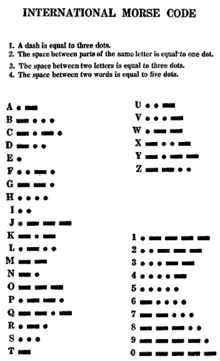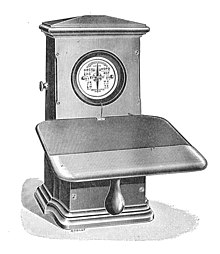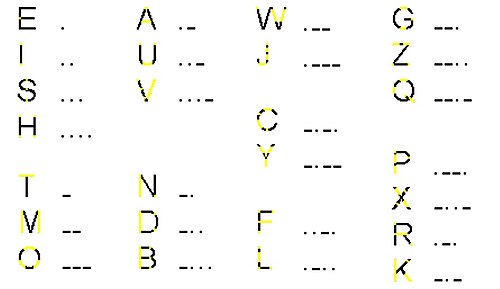Morse code
The Morse code, also known as Morse alphabet or Morse key is a system of representation of letters and numbers by means of signals emitted intermittent.
Development and history
Telegraphs and pre-Morse codes
In the early 19th century, European researchers advanced electrical signaling systems, using a variety of techniques including static electricity and voltaic cell electricity that produce electrochemical and electromagnetic changes. These experimental designs were forerunners of practical telegraph applications.
Following the discovery of electromagnetism by Hans Christian Ørsted in 1820 and the invention of the Electromagnet by William Sturgeon in 1824, there were developments in electromagnetic telegraphy in Europe and America. Pulses of electrical current were sent along wires to control an electromagnet in the receiving instrument. Many of the early telegraph systems used a single needle system which gave a very simple and robust instrument. However, it was slow, as the receiving operator had to alternate between looking at the needle and typing the message. In Morse code, a deflection of the needle to the left corresponded to a "dit" and a deflection to the right to a "dah". By making the two clicks sound different with an ivory and a metal stopper, the single-needle device became an audible instrument, which in turn led to the double-plate voiced telegraph system.
William Fothergill Cooke and Charles Wheatstone in the United Kingdom developed an electrical telegraph that used electromagnets in its receivers. They obtained an English patent in June 1837 and demonstrated it on the London and Birmingham Railway, becoming the first commercial telegraph. Carl Friedrich Gauss and Wilhelm Eduard Weber (1833) as well as Carl August von Steinheil (1837) used codes with variable word lengths for their telegraph systems. In 1841 Cooke and Wheatstone built a telegraph that printed the letters from a wheel of typefaces struck by a hammer.
Samuel Morse and Alfred Vail
American artist Samuel F. B. Morse, American physicist Joseph Henry, and mechanical engineer Alfred Vail developed an electrical telegraph system. He needed a method to transmit natural language using only electrical pulses and the silence between them. Around 1837, Morse therefore developed an early precursor to the modern International Morse code.
The Morse system for telegraphy, which was first used in 1844, was designed to poke holes in a paper tape when electrical currents were received. Morse's original telegraph receiver used a mechanical clock to move a paper tape. When an electrical current was received, an electromagnet pushed an armature that pushed a pencil across the moving paper tape, indenting the tape. When the current was interrupted, a spring would withdraw the pencil and that part of the moving tape remained unmarked. Morse code was developed so that operators could translate the indentations marked on the paper tape into text messages.
In his first design for a code, Morse had planned to transmit only numbers, using a codebook to look up each word based on the number that had been sent. However, the code was soon expanded by Alfred Vail in 1840 to include letters and special characters, so it could be used more generally. Vail estimated the frequency of letter use in the English language by counting what he found in the type cases of a local newspaper in Morristown, New Jersey. The shorter marks were called "dots" and the longer ones "dashes", and the The most commonly used letters were assigned the shortest sequences of dots and dashes. This code, first used in 1844, became known as "Landline Morse Code," "American Morse Code," or "Railroad Morse," until the end of railroad telegraphy in the United States in the 1990s. 1970.
Change from graphic to sound code
In the original Morse telegraph system, the receiver armature made a clicking noise as it moved in and out of position to mark the paper tape. Telegraph operators soon realized that they could translate clicks directly into periods and dashes, and write them out by hand, making paper tape unnecessary. When Morse code was adapted for radio communication, dots and dashes were sent as short and long pulses. It was later discovered that people become more proficient in receiving Morse code when it is taught as a language that is heard, rather than one read from a page.
With the advent of tones produced by radiotelegraphy receivers, operators began to vocalize a dot as "dit" and a hyphen as "dah" to reflect the Morse code sounds they heard. To accommodate the normal sending speed, "dits" that are not the last element of a code were made to be expressed as "di". For example, the letter 'L' is expressed as "di dah di dit". Morse code was sometimes known as "iddy-umpty".
Gerke's refinement of Morse code
Morse code as specified in the current international standard, the "International Morse Code Recommendation", ITU-R M.1677-1, was derived from a greatly improved proposal by Friedrich Clemens Gerke in 1848 it became known as the "Hamburg alphabet".
Gerke changed many of the code points, in the process removing the different length hyphens and different interelement spaces of American Morse Code, leaving only two coding elements, the dot and the hyphen. Codes for the German umlaut and "'SCH"' were introduced. Gerke's code was adopted in Germany and Austria in 1851.
This eventually led to the International Morse code in 1865. The International Morse code adopted most of Gerke's code points. The codes for 'O' and 'P' were taken from a code system developed by Steinheil. Added a new code point for 'J' as Gerke did not distinguish between 'I' and 'J'. Changes were also made to the 'X', 'Y', and 'Z. This left only four code points identical to the original Morse code, namely 'E', 'H', 'K' and 'N', with the latter two having their "dahs" extended to the full length.
Radiotelegraphy and aviation
In the 1890s, Morse code became widely used for early radio communication before voice transmission was possible. In the late 19th century and early 20th century, most high-speed international communications used Morse code on telegraph lines, submarine cables and radio circuits.
Although earlier transmitters were bulky and the spark transmission system was dangerous and difficult to use, there had been some early attempts: In 1910, the US Navy experimented with sending Morse from an airplane. However, the first regular aviation radiotelegraphy was in the aircraft, which had space to accommodate the large and heavy radio equipment then in use. The same year, 1910, a radio on the airship "America" was instrumental in coordinating the rescue of its crew.
During World War I, radio-equipped Zeppelin balloons were used for bombardment and naval surveillance, and ground-based radio direction finders were used for aerial navigation. Allied aircraft and military aircraft also made some use of radiotelegraphy.
However, there was little aeronautical radio in general use during World War I, and by the 1920s, there was no radio system used for flights as important as Charles Lindbergh's from New York to Paris in 1927. Once he and his Spirit of St. Louis were airborne, Lindbergh was truly cut off and alone. Morse code in aviation began its regular use in the mid-1920s. In 1928, when the first airplane flight was made by the Southern Cross from California to Australia, one of its four crew members was a radio operator who communicated with ground stations via radio telegraph.
Starting in the 1930s, both civilian and military pilots needed to be able to use Morse code, both for use with early communications systems and for the identification of navigational beacons that transmitted continuous two- or three-point identifiers. letters in Morse code. Aeronautical charts showed the identifier of each navigation aid next to its location on the map.
Furthermore, fast-moving field armies could not have fought effectively without radiotelegraphy; they were moving faster than their communications services could put up new telegraph and phone lines. This was seen especially in Nazi Germany's Wehrmacht blitzkrieg lightning offensives in Poland, Belgium, France (in 1940), the Soviet Union, and in North Africa; by the British Army in North Africa, Italy and the Netherlands; and by the United States Army in France and Belgium (in 1944), and in southern Germany in 1945.
Maritime flash telegraphy and radiotelegraphy
Radiotelegraphy using Morse code was vital during World War II, especially in the transport of messages between warships and naval bases of belligerents. Long-range ship-to-ship communication was by radiotelegraphy, using encrypted messages because voice radio systems on ships at the time were quite limited in both range and security. Radiotelegraphy was also widely used by warplanes, especially long-range patrol planes that were sent by those naval forces to scout enemy warships, cargo ships, and troop ships.
Morse code was used as the international standard for maritime problems until 1999, when it was replaced by the Global Maritime Distress and Safety System. When the French Navy stopped using Morse code on January 31, 1997, the final message transmitted was "Call All." This is our last message before our eternal silence."
Abandonment of commercial telegraphy
In the United States, the last commercial transmission of Morse code was on July 12, 1999, signing with Samuel Morse the original 1844 message.
Even as of 2015, the United States Air Force still trains about ten people a year in Morse.
The United States Coast Guard has ceased the use of Morse code on radio, and no longer monitors any radio frequencies for Morse code transmissions, including the international distress frequency of 500 kHz. However, the Commission The US Federal Communications continues to issue commercial radio operator licenses to applicants who pass their written tests. There have been licensees who have reactivated the former California Morse Coast Station KPH and regularly broadcast from the site under this signal call or as KSM. Similarly, some American stations on museum ships are operated by Morse enthusiasts.
Morphological functioning
The duration of the point is the minimum possible. A dash is approximately three times as long as a dot. Between each pair of symbols of the same letter there is an absence of a signal with a duration of approximately that of a period. Between the letters of the same word, the absence is approximately three points. For the separation of transmitted words the time is approximately three times that of the dash.
All correspondence between two stations must begin with the call sign. To call, the calling station shall transmit the call sign (not more than twice) of the requested station, the word FROM followed by its own call sign and the signal -. - unless there are special rules peculiar to the type of apparatus used.
Uses
In its beginnings, the Morse alphabet was used in the telegraph lines through the cable laying that was installed. Later, it was also used in radio transmissions, especially at sea and in the air, until voice broadcasting transmitters and receivers arose.
Currently, the Morse alphabet has an almost exclusive application in the field of radio amateurs and scouts, and although its knowledge was frequently required to obtain the amateur radio operator license until 2005, later, the organizations that grant that license in all countries are invited to exempt the candidates from the telegraphy exam.
It is also used in instrument aviation to tune VOR, ILS and NDB stations. The navigation charts indicate the frequency along with a Morse signal that serves, via radio, to confirm that it has been tuned correctly.
Morse alphabet
Click on the links to hear the sound.
| Sign | Code | Sign | Code | Sign | Code | |||||
|---|---|---|---|---|---|---|---|---|---|---|
| A | · — | N | - | 0 | — — — — — — | |||||
| B | · | Ñ | — — — — — — | 1 | · — — — — — | |||||
| C | - · | O | - | 2 | · — — — | |||||
| CH | — — — — | P | · — · | 3 | · · — — | |||||
| D | · | Q | — — — | 4 | · · · | |||||
| E | · | R | · | 5 | · · · · | |||||
| F | · — · | S | · | 6 | · · · | |||||
| G | - | T | - | 7 | — · | |||||
| H | · · · | U | · — | 8 | — — — · | |||||
| I | · | V | · · — | 9 | — — — — | |||||
| J | · — — — | W | · — — | . | · — · — | |||||
| K | - | X | · — | , | — · — — | |||||
| L | · · | And | — — — | ? | · — — · | |||||
| M | - | Z | - · | " | · — · — | / | · · — · |
conventions: —: dash (long sign) : dot (short sign)
If an error is made while transmitting the Morse message, the signal "error" are six echoes "E" in groups of two (../../..):
....--.....---..-...-..
Mnemonic Rule
To facilitate the learning of the Morse code, a mnemonic rule is usually used that allows it to be learned by means of a code consisting of assigning a specific keyword to each letter, which begins with the letter that one wants to remember. Then, it is enough to replace each vowel of the keyword with a dot or an dash according to the following rule:
- The initial keyword is the corresponding letter.
- The number of vowels containing the keyword indicates the length of the morse encoding of that letter.
- If the vowel is a O replaced by a strip (—)
- If any other vowel is replaced by a point (·)
- When replacing, only the points and stripes obtained to the total length in morse will be taken into account.
| Sign | Word | Code | Sign | Word | Code | |
|---|---|---|---|---|---|---|
| A | Asno / Tree | · — | N | Note / Night | - | |
| B | Bonaparte / Bogavante / Bofetada | · | Ñ | Ñoñopatoso / ÑoñoPecoso | — — — — — — | |
| C | Coca-Cola / Hearts | - · | O | Porto / Autumn / Ozone | - | |
| D | Dozen | · | P | Flattons / Pilotonic / Platoons | · — · | |
| E | He/she | · | Q | Cokoriko / Cocoliso / Crocodile | — — — | |
| F | Fumarola / Faraona | · — · | R | Redonda / Ramona / Revólver | . - | |
| G | Gomorrah / Gondola / Gorrones /Gorrona/ Golosa | - | S | Seventh / Seville / Sardina | ... | |
| H | Humareda / Himalaya / Habitant | · · · | T | Tos | - | |
| I | Island / Iris | · | U | Untied / Unique | · — | |
| J | Jabonous | · — — — | V | Vandalism / Ventilator / Vatican | - | |
| K | Kolpino / Koinor / Kosaco | - - | W | Wadopost / Wagon-post / Windows-Dos / Wagogo | . - | |
| L | Lemonade / Limosine | · · | X | Xochimilco / Xolifico / Xoricillo | - - | |
| M | Mozo / Monkey / Moto | - | And | Yonitoco / Yotesoplo / Yosimojo / Yoduroso | — — — | |
| Z | Zocoyula / Zozobraba / ZorroFree | - · |
Graphic mnemonic rule
Another rule to improve the learning of Morse code, resort to the strong presence that the images of the letters have. In order to be the resource that helps memory. In the following letters, the points and lines that correspond to their respective Morse code have been marked with color.
Contenido relacionado
2nd century
History of africa
Assembler






